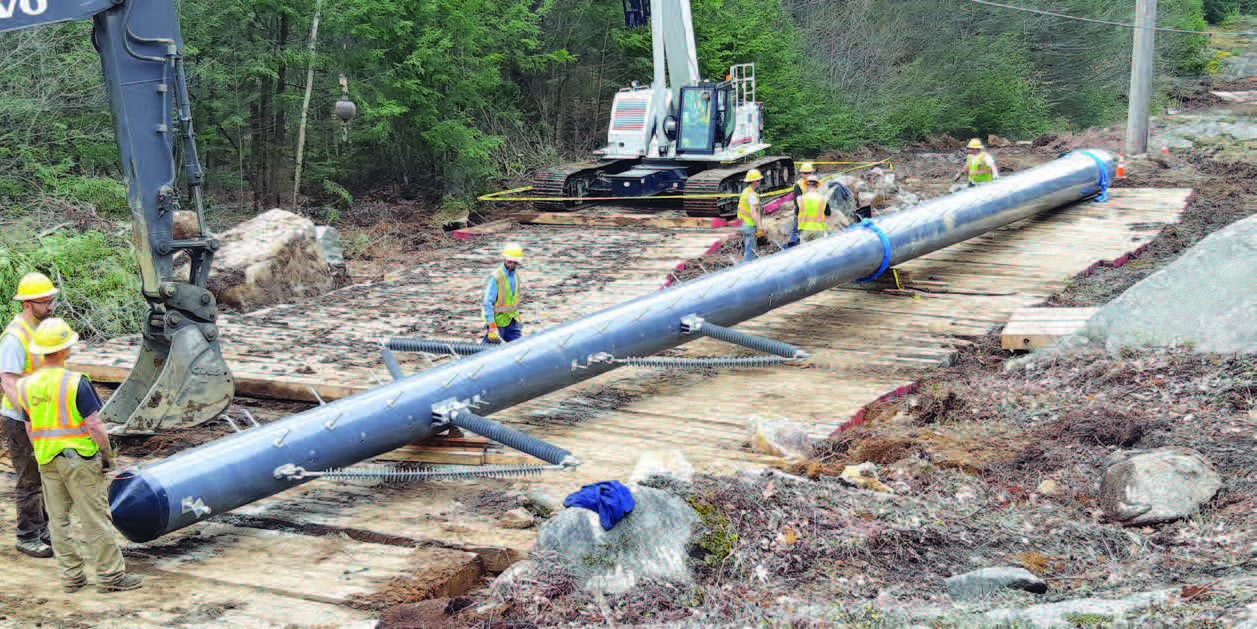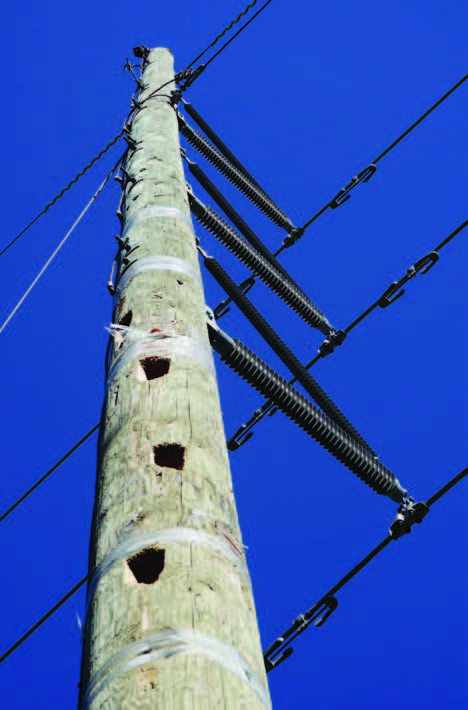
By Galen Fecht, RS Technologies Inc.
There is now a high-performance composite alternative to those ubiquitous wood utility poles that line our streets and sidewalks. The humble utility pole, or telephone pole as it is commonly referred to, carries more than just telephone lines. In fact, any given utility pole will typically support a host of essential services like electricity (i.e. hydro power), voice, and data communication that are critical to empowering our daily lives.
Wood poles have been used for over 175 years and, in that time, they have done a decent job of supporting overhead line networks. But times are changing. The “old growth” wood poles of yesterday were stronger than they are now. First generation poles were treated with preservative chemicals like creosote to slow down rot, whereas today’s wood pole is likely to be a less dense, tree farm-sourced pole treated with less effective preservatives, with less strength, higher deflection, and requiring earlier replacement. This shift in wood pole performance, coupled with the increasingly severe weather and environmental events that many of us are experiencing (think of wildfires and hurricanes), makes the case for pivoting to a more resilient and longer lasting type of utility pole.
Steel and concrete poles are alternative choices, but they have their respective drawbacks. Steel poles are subject to corrosion and are conductive, which presents challenges for utility line crews performing live line installation and maintenance work, and public safety risks when there is an insulator fault. Concrete poles are extremely heavy, which complicates logistics and installation procedures.
So, what else is available as an alternative to the status quo?
The answer is composite poles, which are light weight and deliver reliable, engineered performance. These tubular poles are also known as fibre-reinforced polymer (FRP) or fibreglass poles. Composite poles are comprised of structural fibres, from which the pole derives it strength, and a thermoset resin, which is the “glue” that transfers load stress to and between the fibres. Although composite poles have been in use since the 1960s, it is only within the last 10 years that they have been more widely adopted by electric utility and communication companies. While many factors are driving increased adoption, the rationale can be boiled down to the fact that composite poles solve many of the problems that afflict wood, steel and concrete poles.
What about cost? Are composite poles more expensive than wood poles? A 40 to 50 ft. composite pole commonly used in an overhead electric distribution line will typically be three to five times the cost of a comparable $500 wood pole. But, as with many things we purchase in life, up front price isn’t the entire story. Planning, engineering, labour, transportation, equipment, inspection, and maintenance costs for that $500 wood pole typically add up to about $9,500, bringing the total wood pole cost to $10,000 or more.
Comparatively, the installation of a $2,500 composite pole is about $12,000, which represents only a 20 per cent premium on a total installed cost basis. For pole lengths beyond 50 ft., there is a negative correlation between cost difference and pole length for wood poles and composite poles (i.e. as pole length increases, the cost difference reduces). As we will see, in many situations, this extra cost more than pays for itself.

One reason to use a composite pole instead of a wood pole is simply because wood poles do not last as long as they should. On average, wood poles are expected to last 40 years. However, there are some installations where a wood pole will last only a fraction of that time before it needs to be replaced. In North America, woodpeckers and pests like carpenter ants are responsible for hundreds of millions of dollars in damage to wood poles annually. In some instances, a wood pole can be structurally unfit to support its initial design load in only two or three days after its installation if it is aggressively targeted by woodpeckers. Should that happen to a wood pole, another $10,000 investment is required to again replace the compromised wood pole.
Woodpeckers, ants, and other wildlife can’t damage a composite pole. Replacing the woodpecker damaged wood pole with a composite pole eliminates the need to replace the pole for the next 80 years, which is the average service life of some composite poles. Appreciating that woodpeckers are territorial, a composite pole is a good investment to mitigate future damage and frequent replacement costs.
Premature rot is another situation when a wood pole might not last as long as it should. Because utility poles are embedded into the ground, accelerated wood rot often occurs in wetland areas or regions with high water tables. The use of a composite pole solves the rot problem and, in these applications, is also a superior choice from an environmental perspective. Composite poles also do not contain harmful preservative chemicals that ultimately leach into the ground from wood poles. This makes composite poles an excellent choice in areas where drinking water wells are located, or in sensitive wetland environments.
Speaking of wetlands, these areas typically need specialized equipment to install utility poles, such as tracked vehicles or mobile cranes, and often require swamp mats to facilitate site access. These are additional time and cost considerations that can easily double the installed cost of a pole. This example leads to another reason to use composite poles: where the total installation cost is higher than average. The more remote or off-road a pole location is, the higher the cost to install and maintain that pole. Because composite poles are about 1/3 the weight of a comparable wood pole, lighter duty equipment can be used which typically results in a lower installed cost for a composite pole compared to a wood pole in remote locations.
Yet another application for high-performance composite poles is where reliability is paramount. High winds, ice storms and other natural events are becoming increasingly commonplace. During storms or fires there can be hundreds if not thousands of wood pole failures, which create power outages and delay restoration efforts. Engineered composite poles are designed to withstand extreme loads because they can absorb high amounts of elastic strain energy. Composite poles can flex and better withstand loads, such as a tree falling on a line. Often, it’s the conductor cable or the hardware that attaches the conductor to the pole, that acts as the weak link. Once the load on the pole is released, composite poles return to their vertical orientation and a line crew can merely re-string the conductor to restore electrical service. This is in stark contrast to wood poles that can fail in a cascading manner, requiring large numbers of poles to be procured, transported, and installed, all in advance of the conductor cable being re-strung and service restored.
Moreover, composite poles are fire resistant and can remain standing during and after wildfire events. The bottom line is that composite poles reduce the chances of electrical service interruptions – and they shorten the length of the outages when they do indeed occur.
Currently, composite poles make up less than one per cent of poles installed in the grid, so there is no doubt that wood poles will continue to be used in the future. However, considering both the reliable everyday performance of composite poles as well as their proven performance in severe weather and fire events – considering composite poles for a wide range of applications makes a lot of sense.
Galen Fecht is the Director, Technical Service and the ASCE FRP Committee Chair. For more information, contact RS at info@RSpoles.com.